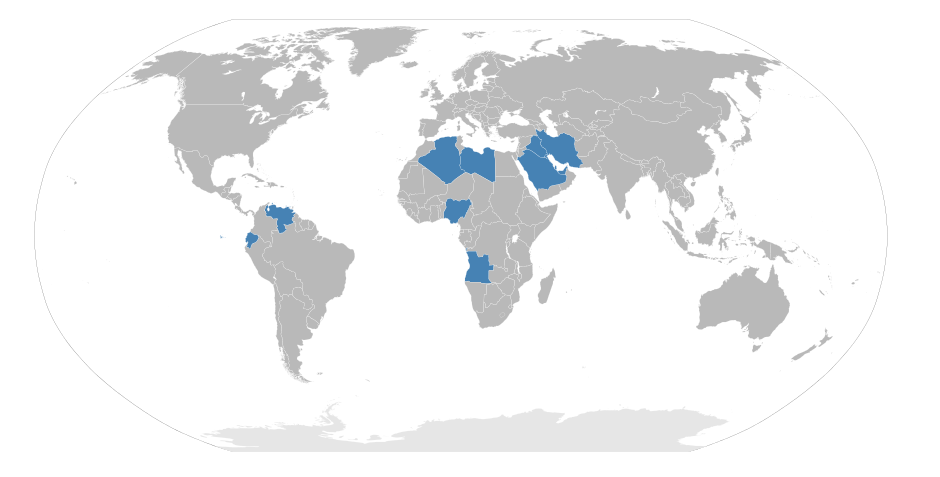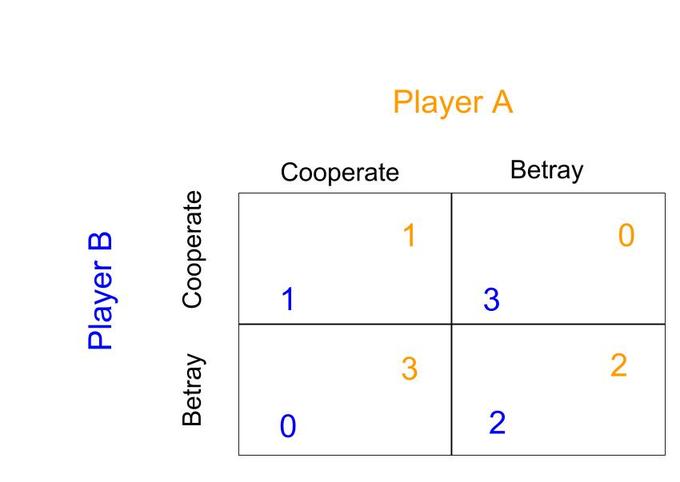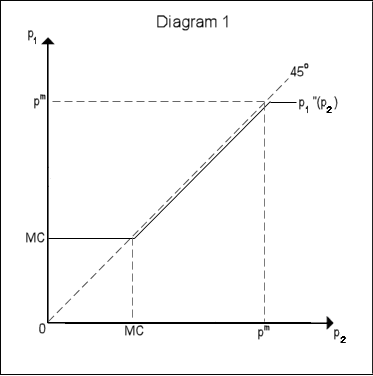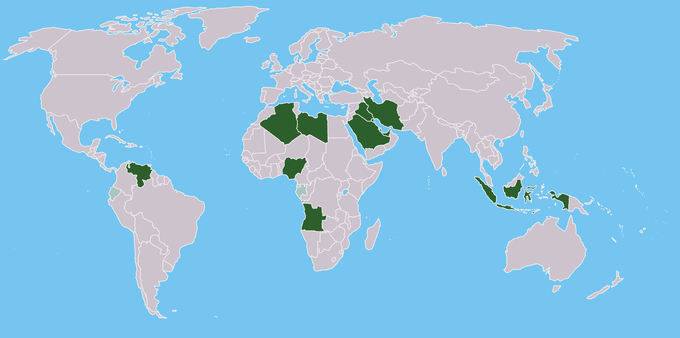

Firms in an oligopoly can increase their profits through collusion, but collusive arrangements are inherently unstable.
Oligopoly is a market structure in which there are a few firms producing a product. When there are few firms in the market, they may collude to set a price or output level for the market in order to maximize industry profits. As a result, price will be higher than the market-clearing price, and output is likely to be lower. At the extreme, the colluding firms may act as a monopoly, reducing their individual output so that their collective output would equal that of a monopolist, allowing them to earn higher profits.

OPEC: The oil-producing countries of OPEC have at times cooperated to raise world oil prices in order to secure a steady income for themselves.
If oligopolists individually pursued their own self-interest, then they would produce a total quantity greater than the monopoly quantity, and charge a lower price than the monopoly price, thus earning a smaller profit. The promise of bigger profits gives oligopolists an incentive to cooperate. However, collusive oligopoly is inherently unstable, because the most efficient firms will be tempted to break ranks by cutting prices in order to increase market share.
Several factors deter collusion. First, price-fixing is illegal in the United States, and antitrust laws exist to prevent collusion between firms. Second, coordination among firms is difficult, and becomes more so the greater the number of firms involved. Third, there is a threat of defection. A firm may agree to collude and then break the agreement, undercutting the profits of the firms still holding to the agreement. Finally, a firm may be discouraged from collusion if it does not perceive itself to be able to effectively punish firms that may break the agreement.
In contrast to price-fixing, price leadership is a type of informal collusion which is generally legal. Price leadership, which is also sometimes called parallel pricing, occurs when the dominant competitor publishes its price ahead of other firms in the market, and the other firms then match the announced price. The leader will typically set the price to maximize its profits, which may not be the price that maximized other firms’ profits.
Game theory provides a framework for understanding how firms behave in an oligopoly.
In an oligopoly, firms are interdependent; they are affected not only by their own decisions regarding how much to produce, but by the decisions of other firms in the market as well. Game theory offers a useful framework for thinking about how firms may act in the context of this interdependence. More specifically, game theory can be used to model situations in which each actor, when deciding on a course of action, must also consider how others might respond to that action.
For example, game theory can explain why oligopolies have trouble maintaining collusive arrangements to generate monopoly profits. While firms would be better off collectively if they cooperate, each individual firm has a strong incentive to cheat and undercut their competitors in order to increase market share. Because the incentive to defect is strong, firms may not even enter into a collusive agreement if they don’t perceive there to be a way to effectively punish defectors.
The prisoner’s dilemma is a specific type of game in game theory that illustrates why cooperation may be difficult to maintain for oligopolists even when it is mutually beneficial. In the game, two members of a criminal gang are arrested and imprisoned. The prisoners are separated and left to contemplate their options. If both prisoners confess, each will serve a two-year prison term. If one confesses, but the other denies the crime, the one that confessed will walk free, while the one that denied the crime would get a three-year sentence. If both deny the crime, they will both serve only a one year sentence. Betraying the partner by confessing is the dominant strategy; it is the better strategy for each player regardless of how the other plays. This is known as a Nash equilibrium. The result of the game is that both prisoners pursue individual logic and betray, when they would have collectively gotten a better outcome if they had both cooperated.

Prisoner’s Dilemma : In a prisoner’s dilemma game, the dominant strategy for each player is to betray the other, even though cooperation would have led to a better collective outcome.
The Nash equilibrium is an important concept in game theory. It is the set of strategies such that no player can do better by unilaterally changing his or her strategy. If a player knew the strategies of the other players (and those strategies could not change), and could not benefit by changing his or her strategy, then that set of strategies represents a Nash equilibrium. If any player would benefit by changing his or her strategy, then that set of strategies is not a Nash equilibrium.
While game theory is important to understanding firm behavior in oligopolies, it is generally not needed to understand competitive or monopolized markets. In competitive markets, firms have such a small individual effect on the market, that taking other firms into account is simply not necessary. A monopolized market has only one firm, and thus strategic interactions do not occur.
The prisoner’s dilemma shows why two individuals might not cooperate, even if it is collectively in their best interest to do so.
Sometimes firms fail to cooperate with each other, even when cooperation would bring about a better collective outcome. The prisoner’s dilemma is a canonical example of a game analyzed in game theory that shows why two individuals might not cooperate, even if it appears that it is in their best interest to do so.
In the game, two members of a criminal gang are arrested and imprisoned. Each prisoner is in solitary confinement with no means of speaking to or exchanging messages with the other. The police offer each prisoner a bargain:

Prisoner’s Dilemma: Betrayal in the dominant strategy for both players, as it provides for a better individual outcome regardless of what the other player does. However, the resulting outcome is not Pareto-optimal. Both players would clearly have been better off if they had cooperated.
For both players, the choice to betray the partner by confessing has strategic dominance in this situation; it is the better strategy for each player regardless of what the other player does. This set of strategies is thus a Nash equilibrium in the game–no player would be better off by changing his or her strategy. As a result, all purely self-interested prisoners would betray each other, resulting in a two year prison sentence for both. This outcome is not Pareto optimal; it is clearly possible to improve the outcomes for both players through cooperation. If both players had denied the crime, they would each be serving only one year in prison.
Similarly to the prisoner’s dilemma scenario, cooperation is difficult to maintain in an oligopoly because cooperation is not in the best interest of the individual players. However, the collective outcome would be improved if firms cooperated, and were thus able to maintain low production, high prices, and monopoly profits.
One traditional example of game theory and the prisoner’s dilemma in practice involves soft drinks. Coca-Cola and Pepsi compete in an oligopoly, and thus are highly competitive against one another (as they have limited other competitive threats). Considering the similarity of their products in the soft drink industry (i.e. varying types of soda), any price deviation on part of one competitor is seen as an act of non-conformity or betrayal of an established status quo.
In such a scenario, there are a number of plausible reactions and outcomes. If Coca-Cola reduces their prices, Pepsi may follow to ensure they do not lose market share. In this situation, defection results in a lose-lose. Which is to say that, due to the initial price reduction by Coca-Cola (betrayal of status quo), both companies likely see reduced profit margins. On the other hand, Pepsi could uphold the price point despite Coca-Cola’s deviation, sacrificing market share to Coca-Cola but maintaining the established price point. Prisoner dilemma scenarios are difficult strategic choices, as any deviation from established competitive practice may result in less profits and/or market share.
The Cournot model, in which firms compete on output, and the Bertrand model, in which firms compete on price, describe duopoly dynamics.
A true duopoly is a specific type of oligopoly where only two producers exist in a market. There are two principle duopoly models: Cournot duopoly and Bertrand duopoly.
Cournot duopoly is an economic model that describes an industry structure in which firms compete on output levels. The model makes the following assumptions:
The Cournot model focuses on the production output decision of a single firm. The firm determines its rival’s output level, evaluates the residual market demand, and then changes its own output level to maximize profits. It is assumed that the firm’s output decision will not affect the output decision of its competitor.
For example, suppose that there are two firms in the market for toasters with a given demand function. Firm A will determine the output of Firm B, hold it constant, and then determine the remainder of the market demand for toasters. Firm A will then determine its profit-maximizing output for that residual demand as if it were the entire market, and produce accordingly. Firm B will be conducting similar calculations with respect to Firm A at the same time.
The Bertrand model describes interactions among firms that compete on price. Firms set profit-maximizing prices in response to what they expect a competitor to charge. The model rests on the following assumptions:
In the Bertrand model, Firm A’s optimum price depends on where it believes Firm B will set its price. Pricing just below the other firm will obtain full market demand, though this choice is not optimal if the other firm is pricing below marginal cost, as this would result in negative profits. If Firm B is setting the price below marginal cost, Firm A will set the price at marginal cost. If Firm B is setting the price above marginal cost but below monopoly price, then Firm A will set the price just below that of Firm B. If Firm B sets the price above monopoly price, Firm A will set the price at monopoly level.

Bertrand Duopoly: The diagram shows the reaction function of a firm competing on price. When P2 (the price set by Firm 2) is less than marginal cost, Firm 1 prices at marginal cost (P1=MC). When Firm 2 prices above MC but below monopoly prices, Firm 1 prices just below Firm 2. When Firm 2 prices above monopoly price (PM), Firm 1 prices at monopoly level (P1=PM).
Imagine if both firms set equal prices above marginal cost. Each firm would get half the market at a higher than marginal cost price. However, by lowering prices just slightly, a firm could gain the whole market. As a result, both firms are tempted to lower prices as much as they can. However, it would be irrational to price below marginal cost, because the firm would make a loss. Therefore, both firms will lower prices until they reach the marginal cost limit. According to this model, a duopoly will result in an outcome exactly equivalent to what prevails under perfect competition. The result of the firms’ strategies is a Nash equilibrium –a pair or strategies where neither firm can increase profits by unilaterally changing the price.
Colluding to charge the monopoly price and supplying one half of the market each is the best that the firms could do in this scenario. However, not colluding and charging the marginal cost, which is the non-cooperative outcome, is the only Nash equilibrium of this model.
The accuracy of the Cournot or Bertrand model will vary from industry to industry. If capacity and output can be easily changed, Bertrand is generally a better model of duopoly competition. If output and capacity are difficult to adjust, then Cournot is generally a better model.
A cartel is a formal collusive arrangement among firms with the goal of increasing profits.
A cartel is an agreement among competing firms to collude in order to attain higher profits. Cartels usually occur in an oligopolistic industry, where the number of sellers is small and the products being traded are homogeneous. Cartel members may agree on such matters are price fixing, total industry output, market share, allocation of customers, allocation of territories, bid rigging, establishment of common sales agencies, and the division of profits.
Game theory suggests that cartels are inherently unstable, because the behavior of cartel members represents a prisoner’s dilemma. Each member of a cartel would be able to make a higher profit, at least in the short-run, by breaking the agreement (producing a greater quantity or selling at a lower price) than it would make by abiding by it. However, if the cartel collapses because of defections, the firms would revert to competing, profits would drop, and all would be worse off.
Whether members of a cartel choose to cheat on the agreement depends on whether the short-term returns to cheating outweigh the long-term losses from the possible breakdown of the cartel. It also partly depends on how difficult it is for firms to monitor whether the agreement is being adhered to by other firms. If monitoring is difficult, a member is likely to get away with cheating for longer; members would then be more likely to cheat, and the cartel will be more unstable.
Perhaps the most globally recognizable and effective cartel is OPEC, the Organization of Petroleum Exporting Countries. In 1973 members of OPEC reduced their production of oil. Because crude oil from the Middle East was known to have few substitutes, OPEC member’s profits skyrocketed. From 1973 to 1979, the price of oil increased by $70 per barrel, an unprecedented number at the time. In the mid 1980s, however, OPEC started to weaken. Discovery of new oil fields in Alaska and Canada introduced new alternatives to Middle Eastern oil, causing OPEC’s prices and profits to fall. Around the same time OPEC members also started cheating to try to increase individual profits.

OPEC: In the 1970s, OPEC members successfully colluded to reduce the global production of oil, leading to higher profits for member countries.
LICENSES AND ATTRIBUTIONS
CC LICENSED CONTENT, SPECIFIC ATTRIBUTION
This page titled 13.2: Oligopoly in Practice is shared under a CC BY-SA 4.0 license and was authored, remixed, and/or curated by Boundless.